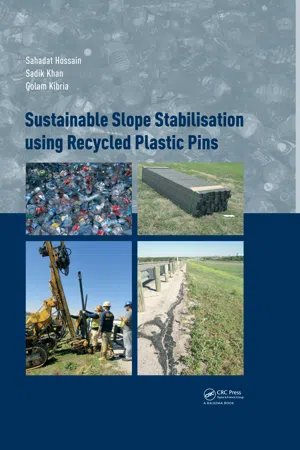![]()
Table of Contents
Preface
About the Authors
1 Introduction
2 Slope failure and stabilisation methods
2.1 Slope Failure
2.2 Shallow Slope Failure
2.3 Variation of Shear Strength of Highly Plastic Clay Soil
2.4 Effect of Rainfall on Slope Stability
2.5 Methods of Repair of Shallow Slope Failures
2.5.1 Slope rebuilding
2.5.2 Pipe piles and wood lagging
2.5.3 Geosynthetic/geogrid repair
2.5.4 Soil-cement repair
2.5.5 Repair with launched soil nails
2.5.6 Earth anchors
2.5.7 Geofoam
2.5.8 Wick drains
2.5.9 Retaining wall
2.5.9.1 Low masonry or concrete walls
2.5.9.2 Gabion walls
2.5.9.3 Shallow mechanically stabilised earth walls
2.5.10 Pin piles (micropiles)
2.5.11 Slender piles
2.5.12 Plate piles
2.5.13 Recycled plastic pins
3 Generation and recycling of plastics
3.1 Introduction
3.2 Generation of Plastic Waste
3.2.1 Global scene
3.2.2 US perspective
3.3 Management of Plastic Waste
3.3.1 Global scene
3.3.2 US perspective
3.3.3 Potential benefits of recycling plastic waste
3.4 Use of Recycled Plastics in Different Applications
3.5 Use of Recycled Plastic for Manufacture of Recycled Plastic Pins
4 Recycled plastic pins
4.1 Introduction
4.2 Manufacturing Process of RPPs
4.3 Engineering Properties of RPPs
4.3.1 Compressive and tensile strength
4.3.2 Flexural strength
4.3.3 Effect of weathering on long-term properties
4.3.4 Creep of RPPs
4.3.4.1 Creep of RPPs in slope stabilisation
4.4 Effect of Environmental Conditions
5 Design methods
5.1 Design Methods
5.2 Limit State Design Method
5.3 Performance-Based Design Approach
5.3.1 Limit failure of soil adjacent to RPPs
5.3.2 Limit resistance of RPPs
5.3.2.1 Limit horizontal displacement of RPPs
5.3.2.2 Limit maximum flexure for prolonged creep life
5.4 Determination of Limit Soil Pressure
5.4.1 Calculation of limit soil pressure
5.4.2 Calculation of limit soil resistance
5.5 Limit Horizontal Displacement and Maximum Flexure of RPPs
5.6 Finalising the Design Chart
5.7 Calculation of Factor of Safety
5.7.1 Approach 1: conventional method of slices
5.7.1.1 Design steps for approach 1
5.7.2 Approach 2: infinite slope
5.7.2.1 Design steps for approach 2
5.8 Design Recommendations
5.8.1 Extent of reinforcement zone
5.8.2 Material selection
5.8.3 Selection of RPP spacing
5.8.4 Minimum RPP length and RPP sections
5.8.5 Recommendations on design method
6 Construction methods
6.1 Early Development of Construction Techniques
6.2 Types of Equipment and Driving Tools for Field Installation
6.2.1 Davey Kent DK I00B drilling rig
6.2.2 Klemm 802 drill rig with KD 1011 percussion head drifter
6.2.3 Deere 200D with FRD F22 hydraulic hammer
6.2.4 Caterpillar CAT 320D LRR with CAT H130S hydraulic hammer
6.3 Field Installation Rate
6.4 Potential Challenges of Rpp Installation
6.4.1 Slope steepness
6.4.2 Skilled labour
6.4.3 Connection between the hammer and pile head
6.5 Special Installation Techniques in Adverse Situations
7 Case studies
7.1 US Highway 287 Slope in Midlothian,Texas
7.1.1 Site investigation
7.1.2 Slope stability analyses at US 287 slope
7.1.3 Slope stabilisation using RPPs
7.1.4 Field installation
7.1.5 Instrumentation and performance monitoring
7.1.6 Performance of RPPs based on the results from instrumentation
7.1.7 Performance of the unreinforced northbound slope
7.2 Highway Slope Near Mockingbird Lane, Dallas,Texas
7.2.1 Site investigation
7.2.2 Slope stability analysis and design of slope stabilisation
7.2.3 Field installation
7.2.4 Field instrumentation and performance monitoring
7.3 Highway Slope at SH 183, Fort Worth,Texas
7.3.1 Site investigation
7.3.2 Slope stability analysis and design of slope stabilisation scheme
7.3.3 Field installation
7.3.4 Field instrumentation and performance monitoring
7.4 Interstate 70 (I-70) Emma Field Test Site in Columbia, Missouri (Loehrand Bowders, 2007)
7.4.1 Site investigation
7.4.2 Slope stabilisation scheme
7.4.3 Field installation
7.4.4 Instrumentation and performance monitoring
7.5 Interstate 435 (I-435)-Wornall Road Field Test Site, Missouri
7.5.1 Site investigation
7.5.2 Slope stabilisation scheme
7.5.3 Field installation
7.5.4 Instrumentation and performance monitoring
Appendix A: Design charts
Appendix B: Sample calculations
References
Subject Index
![]()
Preface
The repair and maintenance due to highway slope failures costs millions of dollars each year in the United States. Highway slope failures are generally surficial in nature, characterised by a failure depth of less than three metres (ten feet). The possibility of highway slope failure is even higher for highway slopes built on expansive clayey soils. In expansive clayey soils, repeated moisture variation due to climatic change causes cracks along the top of highway slopes or highway shoulders. These cracks create pathways for rainwater to seep into the highway slopes. The seeped water increases pore water pressure, decreases soil strength, and eventually leads to highway slope failure.
The conventional slope stabilisation methods (drilled shaft, retaining wall, installation of soil nail, use of geogrids and others) can be expensive and time-consuming for the repair of shallow slope failure. Therefore, new, innovative, sustainable and cost-effective slope stabilisation methods are being tried, tested, and implemented increasingly in recent years. One such method i...
